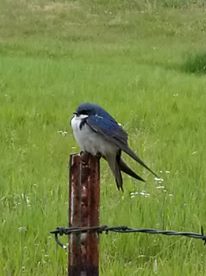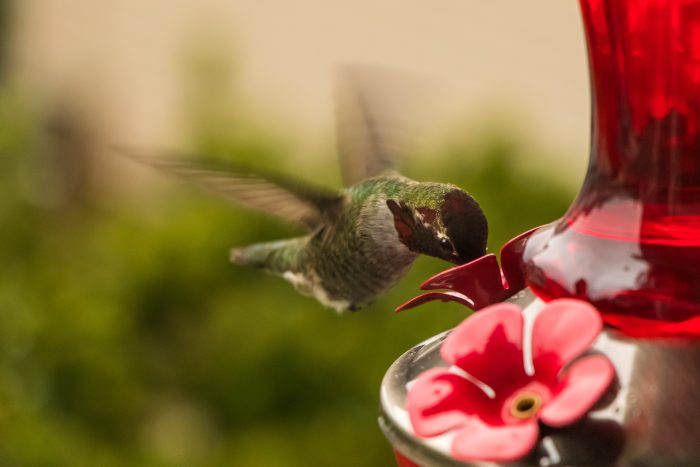The Western Oriole ushers in the morning song. Hummingbirds zip about the front porch, sucking down Frank’s nectar.
Pine Siskins sip water from the fountain on the east side of the house, while the Tanager snatches chunks of suet from the Ponderosa Pine. A Northern Red Flicker awaits his turn, while mama Downy Woodpecker sucks down water from our oldest fountain on the east side of the house.
A vestige of my old life a dozen years ago, the fountain now serves the needs of flocks of birds and the occasional fox, where once it was used to calm the nerves of my soul in post-divorce turmoil. As a sad single girl, a good friend helped me carry the stone structure into my house. After my husband and I met, he helped me move it back outside.
Let’s put in a water heater for the winter season, Frank said.
From then on, in the cold stillness of our Rocky Mountain winters, resident Chickadees, Nuthatches, and Juncos have water to help maintain core body temperature.

With the onset of May comes a fresh population of hummingbirds. Since the return of one on the 26th of April, we’re now up to 10. That’s an average of one every other day, for the past 18 days. Come June, we’ll be up to 40. They’ll stay on until mid-September, when gusting winds from the Continental Divide carry them back down south and across the Gulf of Mexico.
Not long ago, they waited until Memorial Day weekend to arrive. Right along with the summertime tourists.
Frank measures the hummingbird population by the amount of nectar they take from the seven feeders surrounding the house. Come nightfall, they zoom in, sucking down nectar for the chilly mountain evening.
They perch on the feeders with envious compatibility, quietly taking their respective places on literal feeding holes. Leaving no space unoccupied, they thrust long, needle-like beaks into sweet nectar, pausing to glance upward every twelve seconds, or two. The air grows quiet.
All that zooming and trilling is paused like a song on my iPod.
Then, dusk descends like a blanket covering the light of day. Before long, they zoom off into the willows before they lose all light and sense of direction. A belly-full of Frank’s nectar helps them endure the chill of the evening.
In the crack of the new day, the hummingbirds wake, zooming up to the porch feeders and congregating like churchgoers to a Sunday mass. As the eastern sun rises to warm the valley and wake the insects, hummingbirds zoom down to the creek, snatching bits of flying protein. They, along with a plethora of breeding Cliff Swallows occupying Frank’s bird boxes, are working to keep insect populations in check.
Meanwhile, Steller’s Jays swoop and snatch whole peanuts from the flagstone steps. Their nests are across the pasture on the far side of the land, across the creek. When we walk our dogs along the trails, a cacophony of screeching and tweeting erupts. They, in particular, are as fiercely defensive of their environment as the Ukrainian Territorial Defence Unit is against Russian invaders.
Last year, I chanced upon a tangle of avian conflict upon return from a hike: a tiny owl had flown into the jay’s feeding grounds by the Ponderosa Pine. As I walked up on the two entangled birds, the jay’s claws clutched the owl’s. The owl screamed for its life as the jay thrust his powerful beak into its gaping mouth. Leaning down, I pried the jay away.
The owl alighted into nearby branches of safety. The jay threw back its head, thrusting me a look that informed of his immense displeasure for my interference.
I thought to reconsider our quotidian ritual of feeding peanuts to the jays, but dismissed it with a pragmatic reality. When you feed one type of wild bird, you feed them all. Nature doesn’t discern between naughty or nice, large or small. And appetites in nature, especially in climate change-caused droughts, limit vegetation and reduce berry count and wildflowers. The pressures of hardship are overwhelming them all.
Frank reminds in his scientist way that the birds must be here, past the challenging complications of climate change, in order to survive. Populations may be reduced, but in order to sustain, helping them live by supplemental feeding and watering are among the ways to mitigate the deleterious impacts on their environment.
For the most part, I agree.
And I think the hummingbirds do, too. There are no wildflowers yet to speak of, their natural food source. No pasque or blanket flowers, no yellow peas nor lupine. All they have to sustain—to replenish after hundreds of miles across the Gulf of Mexico—is Frank’s nectar, made out of love, care, and devotion, just for them.










Read 14 comments and reply